Making Pound Cake

Five-year-old Joan Pastry saw the cake emerge from the oven and said “Ooh! That’s the kind of cake you put berries and whipped cream on top of!” I have no idea how she knew that, but why fight a perfectly sound impulse?
Making a pound cake can be a no-brainer or a highly complex operation. Me I tend to fuss over them, as it’s a Joe Pastry rule that the simpler a preparation is, the more attention needs to be paid to the technique. A perfectly mixed pound cake can practically sing opera. Start the process by assembling your ingredients and preheating your oven to 350 degrees Fahrenheit. Then grease and flour a 9″ x 5″ loaf pan. If you’re using Baker’s Joy you can do both in one step.
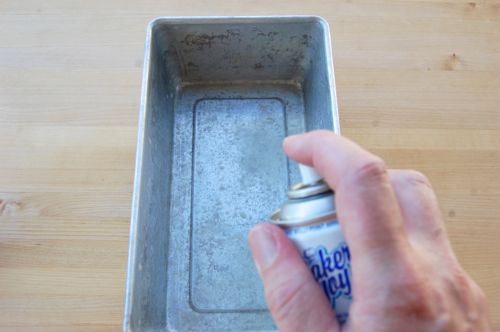
Now sift your cake flour and salt into a medium bowl.
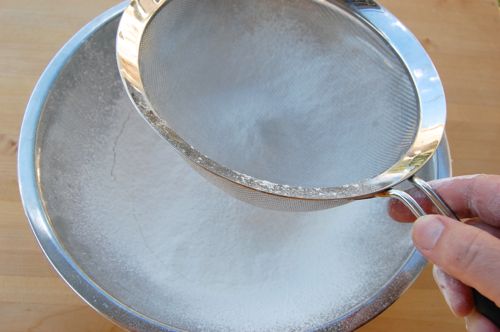
Now’s a good time to add a little flavoring if you like. Here are two teaspoons of citrus rind…lemon and orange, but you can use lime too if you like. Whisk that together.
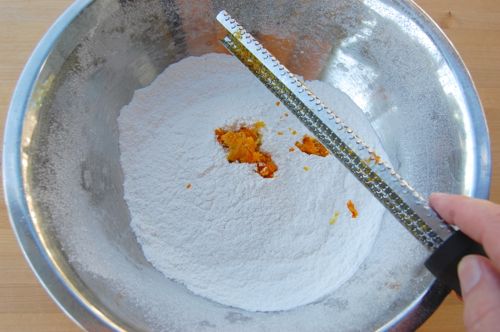
Pour the vanilla into the eggs.

Now combine the sugar and butter in the bowl of your stand mixer. Really good butter will make a difference here if you feel like spending a little green.
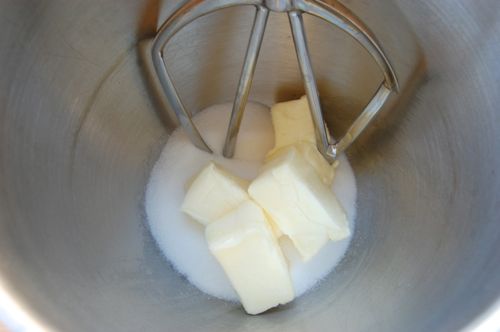
Beat that for about a minute, then scrape.
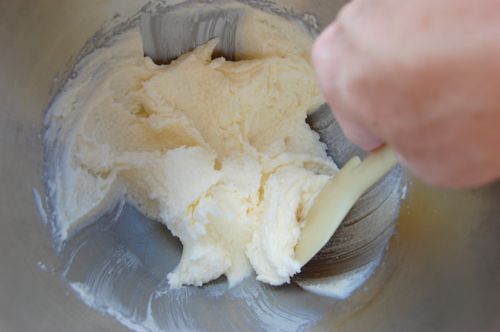
Beat about another three minutes until it’s very pale and fluffy. Now start adding the eggs one at a time. Beat the batter after each egg goes in, until the batter re-fluffs and is no longer wet-looking. It should be light and lustrous. (As a side note I should say that you can whip the whole eggs into a semi-foam if you want to add height…people once did that, you know).
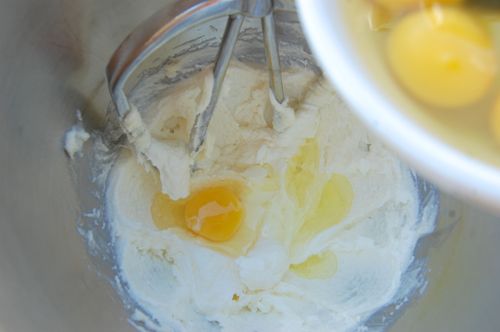
Scrape after three of the eggs have gone in.

By the time all the eggs are in the batter might be a little broken-looking. That’s alright. You don’t want to beat the batter forever. Start adding the flour in a steady stream.
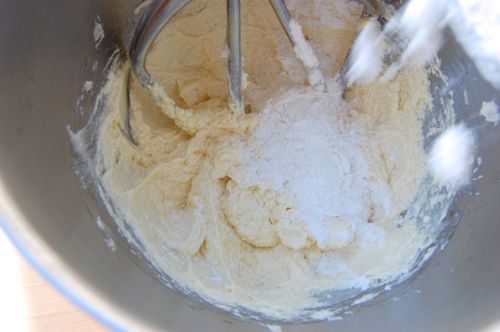
Stir it on low for about a minute until most of the flour has been incorporated. Scrape, then mix another few seconds. In the old days currants were frequently added at this step. Feel free to indulge. Some mini chocolate chips certainly wouldn’t hurt if you’re inclined that way.

Scrape the batter into the pan. Indent the center a little since the middle will crown a bit in the oven. Bake about 70 minutes until a toothpick inserted in the center comes out clean. You may need to tent the cake with foil to keep the top from browning. Check it after an hour to judge that and rotate the pan.
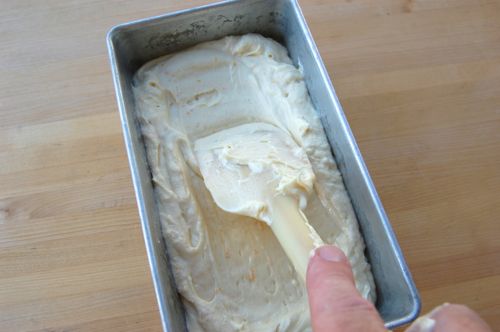
Bake it to about here. Let it cool on a rack for 10 minutes.

To de-pan, place a second rack on top.
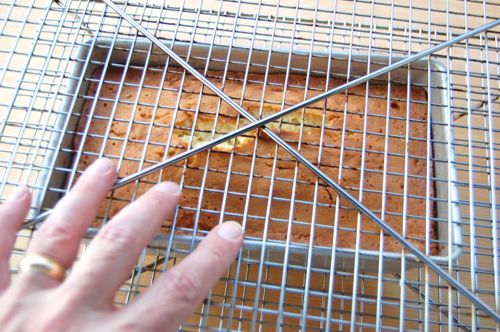
Flip. Remove the top rack and the pan.
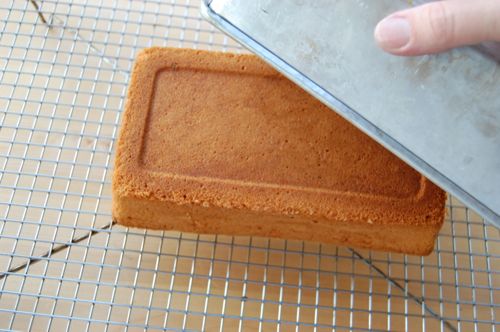
Replace the rack.

Flip. Remove the top rack. Let it cool completely.
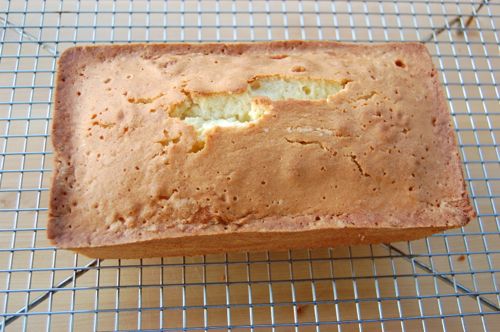
Eat it or freeze it for up to two months. Pound cake is a great thing to have around just in case. It can be sliced horizontally in layers and filled with lemon or lime curd…one of my favorite treatments. But really, you can do just about anything with it, knowdimean?
Hah! You must be so proud – she’s clearly picked up pastry expertise through sugary osmosis!
This looks similar to the recipe from Cook’s Illustrated The Best Recipe book, but that recipe gives all sorts of grave portents if your eggs should start to curdle your creamed butter. Are they exaggerating the dangers?
To some extent, yes. A little “breaking” at the very end of the mixing process isn’t a bad thing. Very rich cake batters tend to look that way, regardless of how much you beat them. And in fact too much beating can put too much air in the batter, causing “mouse houses” (overly large holes in the crumb, especially up high in the loaf). The important thing to my mind is to beat in each egg until the batter doesn’t have a shiny look. If at the very end there’s a little curdling, no big deal.
I have a feeling that the Cook’s Illustated article is referring mostly to cold eggs, which can cause butter in the batter to firm, thus creating “curds”. If that happens, you just keep beating until the temperature is equalized. Again, no big deal…not really.
– Joe
Hah! I knew it! When I make pound cake, it always separates at the end. In most of the recipes I know, they say that separation is a complete disaster, but I found that it doesn’t make a difference when baking, so I already figured that it is a normal thing to happen. Now I know for sure!
I do use self-raising flour in my cake, its the way I learned it and the recipe just works really well like this. And I tend to bake my cake at 160C to prevent it cracking on top…which is a nice thing because I use this recipe also for simple layer cakes.
Very interesting, Ena! Thanks for the note!
– Joe
Love the density of this cake, and it doesn’t look too greasy either, which is also awesome 🙂
Hey Ann!
Great point, I meant to speak to that. It’s the careful mixing of the (room temperature) eggs that keeps the cake from getting greasy. I really don’t like that feature of so many pound cakes.
Cheers!
– Joe
Great recipe!
Thanks, HBM!
– Joe
As a southern girl, I have a very weak spot for pound cake. My grandmother makes an incredible one in a tube pan that she calls a cold oven cake because you start it out in a cold oven. Wicked good.
any tips for making a tuneful pound cake into an operatic one?
Hehe, good question, Leah!
For some reason this one didn’t have quite the flavor I was hoping for. I’m going to bump up the salt a bit, which I think will fix the problem.
– Joe
Hi Joe,
Got as a present duck eggs. Do you think they are suitable for a Pound Cake? If “yes”, probably have to use 4.
Please tell me also, how many grams in 1 stick of butter? The Aussie stick is 250gr. 😉
My kids grew up with this stuff and like it, but as you said, simple things require some fuss and I want to acheve perfection. Usually mix 1/3 with some cocoa to look mabble.
Hey DR!
As long as the weight is the same, the duck eggs should work well. If fact there are some French pastry chefs that swear by ducks eggs. Regarding the butter, an American stick is 4 ounces or about 113 grams.
Send me a picture of your cake!
– Joe
Just not thinking 8 x 30 = 240g
Pretty much exactly right! 😉
– Joe
Made one for my hair stylist. She said pound cake is one of her favorites. I’m not sure what she might do with it for variety. My mom likes a slice for breakfast. Apparently so does my stylist’s mom. Turned out great!
Glad to hear it Linda!
Next time you see her, ask what improvisations she had. I’ll be interested!
– Joe
I cut a piece of parchment with the length a little bit shorter than the length of my pan and the width the width of the roll. Then I center it in the pan using my fingernail to push it into the crease where the bottom meets the sides. There’s lots of excess width to continue up the sides . A binder clip on each side holds it in place until the weight of the batter stabilizes it. Then, once baked, the cake or quick bread is easy to simply lift out by the paper sling after it’s had time to cool and set up a bit.
I thought about doing that, believe it or not. Glad it worked so well!
– Joe
Totally! I’ve been doing it for years.
For something with more sugar like cake or tea breads I spray the pan before I lay in the parchment.
When it’s something that’s just for everyday snacking I also leave the cake/bread in the parchment. We drop it down to take off a slice and just bring it up and around to keep in the moisture in between. If the cake/bread gets stored in a ziplock the paper also makes it easier to lift out and lower back in.
What do you think of Shirley’s idea of adding whipped cream to a pound cake for a ligher, more velvety texture?
Hey Henry!
I’d be inclined to try whipping the eggs first, since cream isn’t really a traditional component of a pound cake. But failing that…why not?
– Joe
I noticed you mentioned more salt (above) because you felt the cake was a little “flat”. I also noted that the batter (I can tell a lot by tasting the batter–raw egg warnings be d***ed). I added some Fiori di Sicilia to my batter. Just a touch–maybe an 1/8 teaspoon. I thought it gave it a little more “life” since I wasn’t adding any flavoring other than the vanilla which seemed light to me. And I adore good vanilla.
Good instincts all. The truth is very few people make straight pound cakes anymore. Almost all of them have some sort of adornment. To me a filled pound cake, one that’s sliced into two or three layers with some jam — or even better some sort of citrus curd — is just about perfect. Thanks for the note, Linda!
All this talk of basic wonderful pound cake is making me want to bake one for myself…and I don’t bake for me but others 99% of the time. The thoughts of a pound cake sitting on the counter for a munch now and then brings back great memories of growing up with one nearly always close at hand.
Amen, sister. It’s great to have on hand…and it keeps all week!
– Joe
You haven’t mentioned a raising agent here whereas all the pound cakes in the blogging world have either baking powder and/or baking soda. Let me know so that i won’t lose faith in pound cakes..
Hey Raquelina!
Love your name! Traditionally pound cakes have no leavening at all. No baking powder or soda…only air bubbles. Here I’m being a traditionalist, but chemical leavening isn’t evil. However I recommend you try them both at different times. We New Worlders are used to the taste of soda in our quick breads and cakes. The clean taste of one without is a nice change of pace!
Cheers,
– Joe
Can you help me?
My mom prides herself on baking pound cakes. She has had the last 3 pound cakes be different. The cake tastes great but there is a streak through the cake that looks like the batter is raw (its not but looks it)
Do you have any idea what happened?
Hi Sherry!
I’ve had that happen with quick breads. Sometimes some of the moisture retreats to the middle of the loaf and gets trapped there, making the center appear raw. This is especially true with larger, bread-sized cakes. It’s just water. However your mom might want to make sure her over isn’t running hot, as that can sometimes aggravate the problem. A longer, lower heat bake will allow more of the moisture to escape.
Cheers,
– Joe